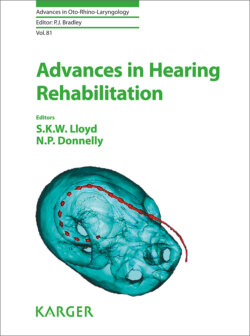Читать книгу Advances in Hearing Rehabilitation - Группа авторов - Страница 16
На сайте Литреса книга снята с продажи.
MRI 3D FLAIR Hydrops Sequences
ОглавлениеA new indication for MRI is the visualization of endolymphatic hydrops. It is performed after the injection of gadolinium contrast. Gadolinium administration can be intratympanic [3], intrathecal or intravenous. Intratympanic administration of gadolinium results in better image quality and higher contrast but it is invasive. Intravenous administration is less invasive and easier to perform, but requires a double dose and has poorer image quality.
This technique is based on the principle that gadolinium is able to pass through the normal “blood-perilymph” barrier but cannot pass through the “blood-endolymph” barrier, so that the perilymph will enhance and the endolymph will not. As result, the non-enhancing endolymphatic spaces (the saccule and the utricle) will be visualized on the background of the perilymph-filled vestibule. The normal scala media is too small to visualize, so the cochlea will show only enhancing scala tympani and scala vestibuli.
In hydropic ears, enlarged confluent non-enhancing endolymphatic areas inside the vestibule will be visible. If this area is still surrounded by an enhancing rim of perilymph, grade 1 vestibular hydrops may be diagnosed (Fig. 5). If the whole vestibular space is taken by the hydrops, we define it as grades 2 vestibular hydrops. In grade 1 cochlear hydrops, black spots are visible at the edges of the cochlea (“Christmas tree” image). In grade 2 cochlear hydrops, black horizontal strips are observed in the cochlea and represent the non-enhancing hydropic scala media which completely replaces the enhancing perilymph in the scala vestibuli, even in the area around the modiolus.
Fig. 4. Axial, sagittal and coronal CBCT and MRI non-EPI DWI “fusion” images: Postoperative evaluation showing 2 recidive/residual cholesteatomas visualized in axial, sagittal and coronal planes by “matching” and “superposition” or “fusion” of a 3T non-EPI DWI image and a CBCT image obtained using dedicated workstations and software.
The maximum enhancement of perilymph is seen 4 h after intravenous gadolinium administration. Therefore, MR imaging must be performed 4 h after the injection. Since enhancement is weak after intravenous administration of the contrast, a double dose of gadolinium is needed and the more sensitive FLAIR sequence is used. To improve the spatial resolution, 3D-FLAIR is applied. Obtaining high resolution requires sequences of 10–15 min so good immobilization of the head is necessary, for example, fixation with the use of. To optimize the signal-to-noise ratio (SNR), a 32-channel coil is used and when possible the coil elements closest to the ears are even positioned between the auricles and the headphones to further increase SNR.
